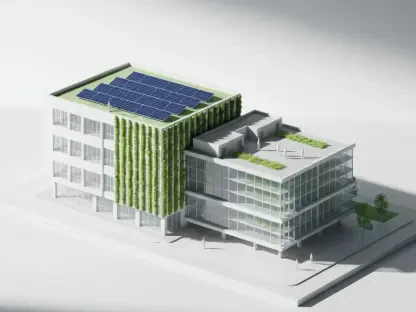In Austin, a groundbreaking initiative underscores a renewed commitment to sustainability by repurposing construction waste from an old school building. The design of this endeavor exemplifies the intersection of environmental consciousness and community engagement, catalyzed by Harvest Lumber Co. They adeptly manage the task of reclaiming vast amounts of wood from the Anita Ferrales Coy Facility’s demolition, a building first erected in the 1950s. This ambition not only prevents waste bloat in landfills but also reshapes how communities perceive building materials, showcasing the true value ingrained in what was once slated as debris. Furthermore, the endeavor aligns with the broader goals of promoting environmental responsibility, spearheaded by the city’s school district. Through this multifaceted approach, the project enhances the neighborhood’s fabric by supporting affordable housing and educational infrastructure.
From Waste to Resource: The Central Theme
Reviving Construction Materials for Sustainability
The project focuses on reimagining how communities handle and perceive materials from demolition sites, especially in terms of environmental impact. By giving discarded construction materials a new lease on life, the initiative contributes meaningfully to Austin’s sustainability efforts. Historically, materials from demolitions often find their end in landfills, exacerbating environmental concerns. However, by diverting these materials for reuse, the project not only conserves natural resources but also significantly reduces potential emissions and energy consumption associated with producing new materials. This reclamation approach challenges traditional views while aligning with environmental sustainability by meaningfully reducing the city’s carbon footprint.
This effort serves as a beacon of how sustainable practices can lead to tangible benefits. By utilizing reclaimed materials, the initiative actively prevents deforestation, which remains a critical environmental concern. Natural wood is a finite resource; its unchecked consumption leads to ecological degradation. Projects like these advocate for smarter resource allocation and encourage a shift towards circular economies, where existing materials are continuously reused and recycled. Such initiatives showcase the seamless fusion of sustainability with practicality, changing the construction landscape and encouraging more eco-conscious practices in urban development.
A Collaborative Movement Toward Green Construction
Green construction no longer stays bound within industry silos; instead, it becomes a community-wide endeavor involving diverse stakeholders. This partnership manifestly nurtures an ecosystem wherein public institutions like the Austin Independent School District (AISD) and private companies can collaborate effectively. AISD embraces sustainability by mandating that significant construction projects repurpose no less than 75% of non-hazardous materials. This ethos resonates with Harvest Lumber Co.’s mission, illustrating a robust example of how partnerships can further social and environmental objectives.
The synergy not only highlights Austin’s progressive take on environmental practices but also provides a template for other communities aiming to become more sustainable. By prioritizing such reclaimed materials, construction now becomes a domain for local employment opportunities, bolstering community ties. This shift influences broader industry trends, with businesses and consumers alike more willing to integrate eco-friendly practices when the social, economic, and aesthetic benefits are visibly apparent. This alignment between governmental policies and private initiatives marks a crucial step toward a sustainable future.
The Role of Businesses in Sustainable Futures
Harvest Lumber Co.: Harnessing Local Resources
Since its inception, Harvest Lumber Co. has become a pioneering force in showcasing how urban sawmills can significantly influence local sustainability. Founded by Kris Burns and Andrew Danziger, the company’s commitment lies in transforming salvage into high-quality materials for varying uses, such as customized furniture and installations. Their expertise not only breathes life into discarded wood but ensures these materials maintain their cultural and historical value. Through partnerships with local businesses and artisans, they convert usable lumber into products cherished for their aesthetics and durability.
The company’s local collaborations showcase its capabilities and foster deep-rooted connections within the community. Harvest Lumber Co.’s dedication to quality and sustainability is exemplified through numerous important projects around the city, ranging from creating functional civic spaces to enriching culinary experiences. These collaborations demonstrate the versatility and beauty of salvaged wood, making it increasingly popular among consumers and businesses. As a result, the company’s initiatives have redefined how Austinites engage with and appreciate reclaimed wood, paving the way for future projects.
Bridging Art and Environmental Stewardship
The infusion of art into sustainability initiatives adds an intriguing layer, transforming practical reclamation schemes into cultural phenomena. Part of Harvest Lumber Co.’s mission involves connecting Austinites with the narrative encapsulated in each piece of wood, inviting creativity through personalized hands-on experiences. This encompasses not only providing wood for bespoke furniture but also collaborating on large-scale art installations, enhancing public spaces with materials rich in historical significance. Consequently, reclaimed wood becomes a medium through which the community can express itself, preserving its architectural and cultural legacy.
The significance of this approach lies in its ability to blend creativity with eco-consciousness. By emphasizing the stories captured within each piece of reclaimed wood, the initiative fosters a deeper appreciation for sustainable practices and the shared heritage of the community. Moreover, it propels a cultural shift where sustainability transcends being an environmental obligation, evolving into an artistic expression that captivates the imagination and inspires broader participation. This approach strengthens community bonds while promulgating the crucial message of environmental responsibility through art and design.
A Compelling Model for Future Sustainable Practices
Empowering the Local Economy through Sustainable Initiatives
Beyond simply promoting sustainability, the reclaimed wood project contributes positively toward empowering the local economy. By creating demand for reclaimed materials, initiatives like those undertaken by Harvest Lumber Co. stimulate the local economy, cultivating skills and providing employment opportunities. Moreover, collaborations between local businesses and artisans ensure that the benefits of these initiatives resonate throughout Austin and neighboring regions. As more patrons embrace locally-sourced and sustainable materials, a new market emerges, incentivizing businesses to adapt and innovate accordingly.
This model also encourages small businesses to incorporate sustainable practices, improving the overall quality of life in the community. As urban areas rapidly expand, there remains a necessity to balance economic growth with ecological preservation. Emphasizing local craftsmanship over mass-manufacture not only supports the environment but thereby invigorates traditional industries by breathing new life into them. The ongoing success of these initiatives illustrates how economic empowerment and environmental stewardship need not be mutually exclusive, providing a replicable model for other localities to follow.
A Future-Oriented Approach for Broader Impact
This project reimagines how communities manage materials from demolition sites, focusing on environmental impact. By repurposing discarded construction materials, it significantly bolsters Austin’s sustainability goals. Traditionally, such materials end up in landfills, heightening environmental issues. However, diverting them for reuse helps conserve natural resources and significantly cuts down on emissions and energy use associated with creating new materials. This reclamation approach not only challenges conventional methods but also aligns with sustainability by reducing the city’s carbon footprint.
The initiative exemplifies how sustainable practices yield tangible benefits. By using reclaimed materials, it actively combats deforestation, a major environmental threat. Natural wood is finite, and unchecked use can lead to ecological harm. Projects like this encourage smarter resource allocation and support circular economies, where materials are reused and recycled continuously. Such initiatives demonstrate the seamless blend of sustainability and practicality, transforming the construction industry and promoting eco-friendly practices in urban development.









